Disclosure: Links marked with * are Affiliate Links. As an Amazon Associate, I earn from qualifying purchases if you decide to make a purchase through these links – at no cost for you!
You are interested in climbing and want to get an overview of all types of climbing? Then have a look at these 12 different indoor and outdoor climbing types below.
If you have any other questions about getting started with climbing, have a look here (How to start Rock Climbing?) and here (Climbing Safety)!
Indoor
1. Top Rope Climbing
 The most classic form of climbing to start climbing is Top Rope Climbing. Top Rope Climbing teaches you how to distribute your balance, how to handle ropes and you train your whole body. Before moving on to more difficult or complex climbing styles, Top Rope Climbing with bouldering is the best way to get started in the world of climbing.
The most classic form of climbing to start climbing is Top Rope Climbing. Top Rope Climbing teaches you how to distribute your balance, how to handle ropes and you train your whole body. Before moving on to more difficult or complex climbing styles, Top Rope Climbing with bouldering is the best way to get started in the world of climbing.
With Top Rope Climbing, the rope is guided upwards from the climber to a pulley under the ceiling. Among other things, this also serves as a pulley block. From there, the rope goes all the way down to the belayer, who continuously secures the climber. He always keeps the rope slightly under tension so that he can react quickly in the event of a fall.
This type of climbing is very safe due to the type of securing. The fall distance is minimal and the impulse is absorbed by the rope and the climbing harness. In many climbing halls, the pulleys have built-in stoppers which, similar to a safety belt in a car, automatically brake the rope when it is heavily pulled.
2. Bouldering
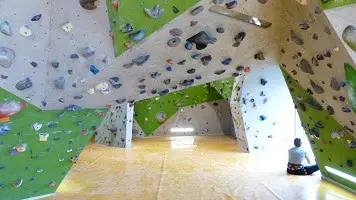 When bouldering, you only climb a few meters high and are only secured by a sports mat on the ground. That’s why you need so little equipment here. Besides comfortable clothes you only need climbing shoes and magnesium powder or climbing chalk for bouldering. (No idea what Chalk is? Look here.)
When bouldering, you only climb a few meters high and are only secured by a sports mat on the ground. That’s why you need so little equipment here. Besides comfortable clothes you only need climbing shoes and magnesium powder or climbing chalk for bouldering. (No idea what Chalk is? Look here.)
Top rope climbing and bouldering are like jogging and sprinting. What matters here is not the route you climb, but the degree of difficulty. In bouldering, the routes are usually called “problems” and they are divided into standardized levels of difficulty.
If you go to a climbing hall and try your hand at a boulder wall, you will find very easy routes and routes that seem physically impossible.
Bouldering is often used as training because of the high effort and the partly technically difficult movements. How to train your grip strength for climbing is described in this article.
Bouldering is also ideal for people who don’t seriously want to start climbing, but just want to bring variety into their workout routine.
3. Lead Climbing
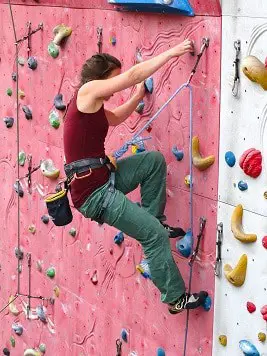 During lead climbing, the climber climbs without a rope from above. But don’t worry – he takes the rope with him and hooks it into the wall using regularly placed anchors on the way. These anchors have carabiners (or Quickdraws) to which the rope can be clipped.
During lead climbing, the climber climbs without a rope from above. But don’t worry – he takes the rope with him and hooks it into the wall using regularly placed anchors on the way. These anchors have carabiners (or Quickdraws) to which the rope can be clipped.
So the rope goes from the climbing harness to the next anchor, down through all the other anchors already reached to the person securing on the ground. As long as you follow a few small rules when clipping-in the rope, lead climbing is just as safe as top rope climbing.
Lead climbing should only be attempted after gaining some experience. The risk is slightly higher than with top rope climbing and the falls are slightly higher and therefore harder. For this reason, the belayer must also be trained to catch such falls on the ground.
More info: How to Lead Climb
Outdoor
1. Bouldering
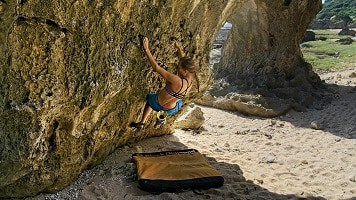 You can also boulder outdoors. It’s even more fun there, because you don’t have to climb pre-made routes, but have to find your own way.
You can also boulder outdoors. It’s even more fun there, because you don’t have to climb pre-made routes, but have to find your own way.
In a climbing hall, you have thick sports mats under the rock imitations. In nature, you have to bring your own sports mat, which is called crash pad. Maybe you’ve seen boulderers hiking before. You always recognize them by the fact that they carry a huge, foldable mat on their back like sherpas in the Himalayas.
Since the size of this mobile mat is, of course, limited, you always have to be careful not to climb on the rock in such a way that you leave the padded area underneath you.
Otherwise, you only need the right climbing shoes and climbing chalk. Bouldering is far more relaxed in terms of equipment, risk, logistics and preparation. If you are not interested in the view from above or the thrill of the heights, bouldering is perfect!
2. Sport Climbing
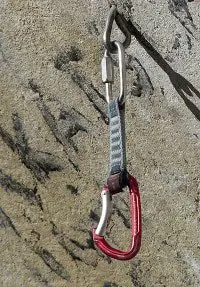 Sport climbing can best be compared to indoor climbing with ropes. You mostly lead climb and always hook into the next anchor with quickdraws (a quickdraw consists of two carabiners, which are connected by a short sling). These anchors are previously firmly placed and usually drilled into the rock. The routes are divided into difficulty levels so that you know in advance what to expect.
Sport climbing can best be compared to indoor climbing with ropes. You mostly lead climb and always hook into the next anchor with quickdraws (a quickdraw consists of two carabiners, which are connected by a short sling). These anchors are previously firmly placed and usually drilled into the rock. The routes are divided into difficulty levels so that you know in advance what to expect.
Just like in the climbing hall, the climber is then secured by the belayer. The rope goes from the person securing the rope through the anchors to the climber.
Since you don’t have to worry about the placement of the anchors and the route is more or less determined by the anchor placement, the focus of sport climbing is more on the sporting aspects such as strength, endurance and technique. You can also relax and enjoy the view!
3. Traditional / Trad Climbing
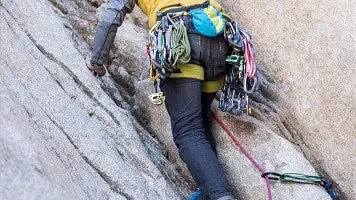 In trad climbing, the rock is still untouched without prefabricated anchors. The challenge in trad climbing is to find your own way and set the anchors yourself.
In trad climbing, the rock is still untouched without prefabricated anchors. The challenge in trad climbing is to find your own way and set the anchors yourself.
The climber is secured with a rope from the climber through the karabiners on the anchors to the person securing on the ground.
Trad Climbing is much more complex than sport climbing due to the self-construction of the anchors and you have to carry a lot more equipment. If you want to put together your first equipment for trad climbing, have a look at this detailed guide.
As you can imagine, attaching your own anchors is more prone to failure than a solid bolt in the stone. Therefore, traditional climbing is more exciting but also more dangerous than sport climbing, as you are 100% dependent on your equipment and self-made anchors.
The name “traditional” comes from the fact that this was the first form of free climbing outdoors. Before there were prefabricated routes with fixed anchors, there were of course already climbers. Therefore, this form of climbing is called traditional. Climbing did not become more popular until the 70s and 80s, which meant that even less die-hard climbers could be brought to the rock thanks to the permanently installed anchors.
4. Multi-Pitch Climbing
 With multi-pitch climbing, you climb higher than one rope length in one climb. On such routes you need a strategy how to climb further at the end of the rope. The most common way is to change the roles of the climber and the belayer. When the climber has almost reached the end of the rope’s range, he climbs back a little so that the last anchor is a bit above him. Then the lower climbing partner climbs up, past the new belayer and again as far as the rope goes. This continues until you reach the top. So you always have a break in between.
With multi-pitch climbing, you climb higher than one rope length in one climb. On such routes you need a strategy how to climb further at the end of the rope. The most common way is to change the roles of the climber and the belayer. When the climber has almost reached the end of the rope’s range, he climbs back a little so that the last anchor is a bit above him. Then the lower climbing partner climbs up, past the new belayer and again as far as the rope goes. This continues until you reach the top. So you always have a break in between.
A multi-pitch route can be climbed either traditionally or with fixed anchors.
Before you start such a big adventure, you should know everything about the route:
- How long does it take?
- How much equipment do I need?
- How do I get back down? (hiking/rappeling/etc.)
- What is the degree of difficulty?
5. Aid Climbing
In aid climbing, the equipment carried is not only used for securing. The rock face is equipped with mobile or fixed hooks, rope ladders, ropes, etc. to artificially build a support. The possibilities are unlimited so that with suitable equipment you can also get past a horizontal rock ledge.
This way of climbing is very pragmatic and concentrates only on climbing to the top with the help of equipment. This type of climbing dates back to the beginning of the last century and has been refined over time. Where in those days permanently installed climbing aids were often used, mobile equipment fortunately prevails today.
The disadvantage of aid climbing is that it can sometimes take a long time to climb a relatively short distance. On one day you can climb up to 1000 meter high cliffs. Due to this fact and the fact that the equipment makes up such a large part of aid climbing, it is not uncommon for climbers to spend the night on the rock face! A hammock, a sleeping bag and a large portion of courage are necessary to sleep in such dizzying heights.
6. Ice Climbing
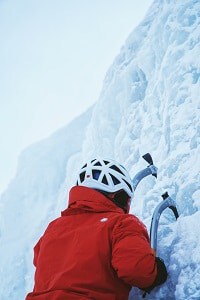 As the name suggests, ice climbing does not involve climbing up rocks, but ice. This ice is mostly frozen waterfalls that you climb vertically.
As the name suggests, ice climbing does not involve climbing up rocks, but ice. This ice is mostly frozen waterfalls that you climb vertically.
As you can imagine, this form of climbing is more dangerous than rock climbing. The ice should be completely hardened and even then it is not as stable as rock and does not provide as much support.
In addition to the usual equipment such as a climbing harness, helmet, rope, etc., ice climbing equipment also includes spikes on the shoes and ice picks that you drive into the ice to get a grip.
So-called ice screws are used for securing. These are long screws with an anchor at the end. As they are relatively large to provide sufficient support, they are hollow from the inside and made of light material.
You should also think twice about what type of ascent you choose. When lead climbing, you would not be protected if the ice gave way. Even the most careful securing is useless if the piece of ice on which it is attached falls into the depths. The safer option would be toprope climbing with a rope from above, which is securely anchored there.
7. Alpine Climbing (Mountaineering)
 Alpine climbing brings all disciplines together since the goal is the top of the mountain. Which types of climbing are actually used depends of course on the mountain.
Alpine climbing brings all disciplines together since the goal is the top of the mountain. Which types of climbing are actually used depends of course on the mountain.
Whether you reach the top traditionally, with or without permanently installed hooks or with technical aids is irrelevant.
Since climbing a mountain is a big and also dangerous undertaking, a detailed planning is necessary. You have to be able to estimate how long it will take to get the necessary provisions and which equipment is needed.
The equipment is the same as that of a traditional climbing route plus suitable clothing, if necessary ice climbing equipment and (if required / wanted) technical aids such as ladders, hooks etc.. In addition, twin or half ropes are used on such long routes to reduce the risk of rope tear.
Securing is usually the same as with multi-pitch climbing with lead climbing. Such multi-rope climbing routes can also be climbed in a team of three. Usually two half ropes are used, whereby the leader is connected with both ropes and the two following climbers are each connected to one rope.
The descent takes place at the end via hiking routes or by abseiling/rappelling.
8. Deep Water Soloing
 A completely different kind of safety when climbing is water. With Deep Water Soloing you climb a wall without any other safety equipment. This allows you the freedom of bouldering paired with the distance from normal rock climbing. Of course, this is not completely unrisky – an uncontrolled fall from great heights onto the water should not be underestimated.
A completely different kind of safety when climbing is water. With Deep Water Soloing you climb a wall without any other safety equipment. This allows you the freedom of bouldering paired with the distance from normal rock climbing. Of course, this is not completely unrisky – an uncontrolled fall from great heights onto the water should not be underestimated.
Deep Water Soloing was originally practiced only on natural cliffs with a lake, river or sea under the climber. Nowadays, however, there are also artificial walls built over swimming pools.
The basic requirement for deep water soloing is that the wall extends continuously at an angle above the water so that you cannot hit the wall in the event of a fall. And, as the name suggests, the water should be deep enough.
9. Free Soloing
 The most spectacular way of climbing – you have to be an adrenaline junkie for free soloing. Because free soloing is practically suicide. You climb the mountain without ropes or other safety devices. Fortunately there are only a few lunatics who do this and if they do, they at least choose easy routes and take it slow.
The most spectacular way of climbing – you have to be an adrenaline junkie for free soloing. Because free soloing is practically suicide. You climb the mountain without ropes or other safety devices. Fortunately there are only a few lunatics who do this and if they do, they at least choose easy routes and take it slow.
Recap
These were 12 different types of climbing, each of which is exciting and challenging in its own right. No matter which type you choose, the most important thing is always to slowly increase the difficulty and have the right equipment ready.
I hope that there was something here for you and wish you a lot of fun while climbing!
Attention: You have to take care of your safety when climbing! The information on climbtheearth.com only helps you to learn. Before you climb, you should make sure that you have been properly instructed by an expert and that you follow all safety precautions.
Disclosure: This website is the property of Martin Lütkemeyer and is operated by Martin Lütkemeyer. Martin Lütkemeyer is a member of the Amazon Services LLC Affiliate Program, an affiliate advertising program designed to enable Web sites to earn advertising revenue through advertising and linking to Amazon.com. Links marked with * are affiliate links.